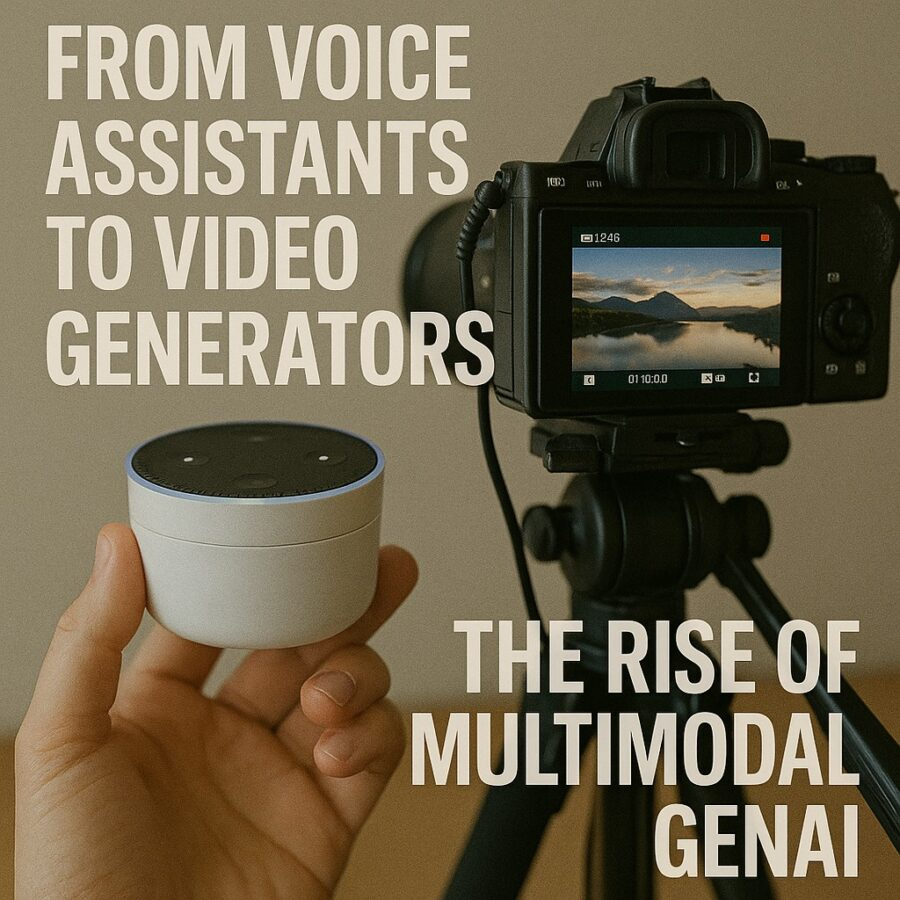Views: 3
Artificial intelligence has moved from novelty to necessity in less than a decade. What began with simple voice interactions has expanded into a full spectrum of generative capabilities. Today, the story of progress can be summed up as from voice assistants to video generators, capturing the evolution of multimodal systems that now produce sound, text, images, and film with startling fluency.
This transition marks one of the most significant shifts in technology since the arrival of the internet. It is not just about more advanced software but about a new way of interacting with machines. Multimodal generative AI reshapes creativity, industry, and even personal identity.
The Era of Voice Assistants
Voice assistants like Siri, Alexa, and Google Assistant ushered in the first wave of natural language interfaces. They showed that machines could respond conversationally and handle tasks such as setting alarms, checking weather, or controlling smart homes.
While groundbreaking, their abilities were narrow. Responses were scripted, and mistakes were frequent. Yet these early systems created the cultural shift needed to accept talking to machines as normal. Without that foundation, the leap from voice assistants to video generators would have seemed implausible.
The Leap to Multimodal AI
The real revolution began when AI moved beyond single channels of communication. Large language models demonstrated that machines could produce convincing text. Image generators like DALL·E and Midjourney brought visual creativity into the mix. Speech-to-text and text-to-speech systems closed the loop, enabling seamless dialogue.
Now video generation has entered the landscape. Tools can create short films, advertisements, or educational clips from simple prompts. This convergence of text, audio, and visual capacity is why experts call it multimodal generative AI. The trajectory from voice assistants to video generators reveals how quickly narrow tools became expansive creative platforms.
Why Multimodality Matters
The human brain is multimodal. We learn and communicate through sight, sound, and language together. Machines that can do the same feel more natural to interact with.
Multimodal AI also unlocks new opportunities:
- Education: Interactive lessons that combine narration, visuals, and video adapt to different learning styles.
- Healthcare: Systems can process patient speech, analyze visual scans, and generate explanatory videos for treatment plans.
- Business: Marketing teams can move from writing slogans to producing full campaigns with images, jingles, and commercials.
The rise from voice assistants to video generators is not just about adding features but about aligning technology with the way humans experience the world.
Creativity Reimagined
Artists and creators stand at the center of this shift. Writers use multimodal systems to turn stories into illustrated novels. Musicians collaborate with AI that generates video clips matching their tracks. Independent filmmakers produce scenes without massive budgets, relying on generative systems to handle background settings and visual effects.
For some, this feels like empowerment. For others, it sparks fear of dilution. What does originality mean when a model trained on millions of examples suggests the next note or frame? The tension illustrates how the journey from voice assistants to video generators challenges traditional definitions of creativity.
The following is a referral or affiliated link that AltPenguin receives compensation for, should the link be used and the offer is completed. To provide full transparency, we at AltPenguin are stating this before you click the image below (the image will open a new page to the offer shown in the image).
Jobs in the Multimodal Era
Employment inevitably shifts with technological revolutions. Multimodal AI creates efficiency but also disruption.
- Media production: Editing and animation jobs may shrink as AI handles basic tasks. Yet new roles emerge in directing prompts, curating outputs, and ensuring quality.
- Education: Teachers may spend less time preparing slides and more time guiding personalized learning experiences generated by AI.
- Corporate communication: Reports and presentations may be drafted with integrated visuals and audio narration at the push of a button.
The pattern is familiar. Automation removes some roles while introducing others. The rise from voice assistants to video generators is less about replacing humans entirely and more about redefining professional value.
Ethical and Social Concerns
With greater power comes greater risk. Deepfakes illustrate the danger of convincing but deceptive video. Voice cloning raises concerns about fraud and misinformation. Multimodal systems blur the line between authentic and synthetic content.
Regulators and developers face the challenge of building safeguards. Watermarking, content detection, and responsible data sourcing are part of the solution. Yet ethics extends beyond technical fixes. Society must decide how to balance creative freedom with trust and accountability.
The debate shows that from voice assistants to video generators, progress brings not only opportunity but responsibility.
The Technical Foundations
Behind the scenes, multimodal AI depends on breakthroughs in machine learning. Transformers, attention mechanisms, and massive training datasets enable models to connect different types of information.
Cross-modal learning allows systems to interpret text descriptions and generate visuals. Audio-visual fusion lets machines synchronize lip movements with speech. Video diffusion models build moving frames from still images.
These foundations highlight why the leap from voice assistants to video generators happened so quickly. Once the architecture was in place, extending it across modalities became achievable.
Industry Leaders Driving the Change
Several companies lead the multimodal charge. OpenAI integrated image and voice features into its models. Google developed Gemini to operate seamlessly across text, image, and audio. Startups focus on specialized video generation tools aimed at marketing and entertainment.
The competition drives rapid iteration. Features that seemed futuristic last year are becoming everyday tools. The corporate race accelerates the climb from voice assistants to video generators, ensuring the landscape will not remain static.
The following is a referral or affiliated link that AltPenguin receives compensation for, should the link be used and the offer is completed. To provide full transparency, we at AltPenguin are stating this before you click the image below (the image will open a new page to the offer shown in the image).
Education and Accessibility
One of the most promising applications is education. Multimodal systems can generate lessons tailored to individual needs. Students who struggle with reading may benefit from narrated video summaries. Those who learn visually can access dynamic illustrations.
Accessibility also improves. People with disabilities may interact with machines more naturally through combinations of voice, gesture, and visual cues. This inclusivity underscores the positive side of the journey from voice assistants to video generators, proving that multimodality can expand opportunity as well as efficiency.
Cultural Shifts
Cultural norms shift when technology changes communication. The telephone altered family ties. Television reshaped politics. The internet transformed relationships. Multimodal AI will be no different.
As synthetic video becomes common, society will adapt to a world where seeing is no longer believing. Entertainment will blend human and machine creativity seamlessly. Children will grow up with AI tutors that explain concepts through animated stories.
The rise from voice assistants to video generators is not just technical. It is cultural, influencing how people trust, learn, and imagine.
The Global Competition
Multimodal AI is also a geopolitical race. Nations view leadership as vital for economic growth and cultural influence. The United States, China, and the European Union invest heavily in research and regulation. Emerging economies see opportunities to leapfrog into advanced industries.
Global collaboration could align standards for ethics and safety. Yet rivalry may push speed over caution. The contest from voice assistants to video generators mirrors earlier battles over space exploration and nuclear power, where innovation was inseparable from politics.
Future Horizons
Looking ahead, multimodal AI will not stop at video. Research already explores immersive 3D environments and interactive virtual worlds. Integration with augmented and virtual reality could create companions that respond across all senses.
The ultimate endpoint may be fully embodied agents capable of interacting in physical space through robotics. The journey from voice assistants to video generators is thus one stage in a longer arc where machines approach human-like versatility.
A Balanced Perspective
Excitement about progress should not eclipse realism. Limitations remain. Generated videos often struggle with coherence beyond short clips. Voices sometimes lack emotional nuance. Ethical risks persist.
Yet dismissing the technology would be equally shortsighted. Multimodal AI is advancing faster than any previous media innovation. The challenge is to adopt with caution while exploring new frontiers. The story from voice assistants to video generators is not about perfection but about momentum.
The following is a referral or affiliated link that AltPenguin receives compensation for, should the link be used and the offer is completed. To provide full transparency, we at AltPenguin are stating this before you click the image below (the image will open a new page to the offer shown in the image).
Closing Thoughts
The path of artificial intelligence has always mirrored human ambition. We seek to replicate the way we communicate, create, and connect. Multimodal systems bring that ambition closer to reality by uniting language, vision, and sound.
The rise from voice assistants to video generators represents more than technical progress. It signals a shift in how humanity will experience knowledge, art, and society in the years ahead. The choices made now—about ethics, accessibility, and governance—will determine whether this technology becomes a tool for empowerment or a source of disruption.
History shows that every revolution brings both light and shadow. The multimodal revolution will be no different. What matters is how we guide it.





